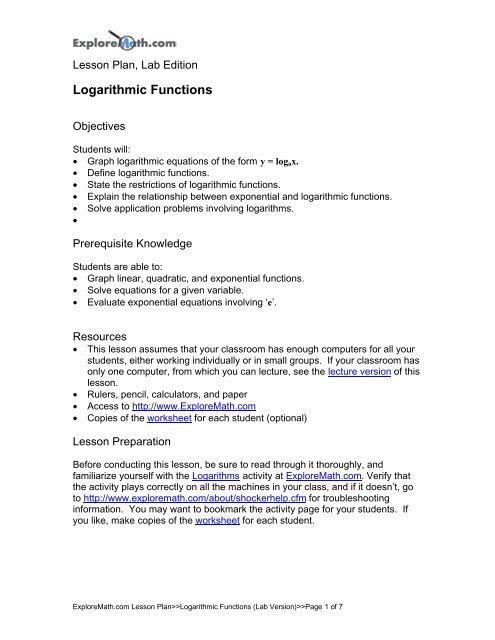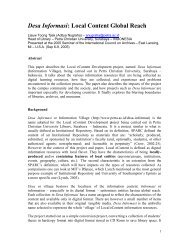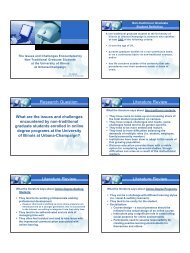Logarithmic Functions
Logarithmic Functions
Logarithmic Functions
Create successful ePaper yourself
Turn your PDF publications into a flip-book with our unique Google optimized e-Paper software.
Lesson Plan, Lab Edition<strong>Logarithmic</strong> <strong>Functions</strong>ObjectivesStudents will:• Graph logarithmic equations of the form y = log a x.• Define logarithmic functions.• State the restrictions of logarithmic functions.• Explain the relationship between exponential and logarithmic functions.• Solve application problems involving logarithms.•Prerequisite KnowledgeStudents are able to:• Graph linear, quadratic, and exponential functions.• Solve equations for a given variable.• Evaluate exponential equations involving ‘e’.Resources• This lesson assumes that your classroom has enough computers for all yourstudents, either working individually or in small groups. If your classroom hasonly one computer, from which you can lecture, see the lecture version of thislesson.• Rulers, pencil, calculators, and paper• Access to http://www.ExploreMath.com• Copies of the worksheet for each student (optional)Lesson PreparationBefore conducting this lesson, be sure to read through it thoroughly, andfamiliarize yourself with the Logarithms activity at ExploreMath.com. Verify thatthe activity plays correctly on all the machines in your class, and if it doesn’t, goto http://www.exploremath.com/about/shockerhelp.cfm for troubleshootinginformation. You may want to bookmark the activity page for your students. Ifyou like, make copies of the worksheet for each student.ExploreMath.com Lesson Plan>><strong>Logarithmic</strong> <strong>Functions</strong> (Lab Version)>>Page 1 of 7
LessonMotivation:Warm-up: Who wants to be a millionaire?When someone asked Albert Einstein what he considered mankind’s greatestinvention, he’s said to have replied without hesitation, "compound interest."Interest that is compounded continuously is modeled by the equation A = Pe rt ,where ‘A’ is the amount after ‘P’ dollars is invested for ‘t’ years at rate ‘r’.Historically the U.S. stock market has an average rate of return between 8-10%.Have your students plot a graph that shows the growth of $10,000 at an interestrate of 10% over the next 10, 20, 30, 40, and 50 years. The graph should look likethe one below.$1,600,000$1,400,000$1,200,000$1,000,000$800,000$600,000$400,000$200,000$00 10 20 30 40 50 60Have students notice how the graph increases.Ask students how long they would need to keep the $10,000 invested in order tohave $1 million in 50 years. If the students are around 17 years old, 50 years fromnow will be close to the U.S. Social Security retirement age.In order to solve the problem, the equation 1,000,000 = 10000e ((0.10)(t)) needs to besolved for the value of ‘t’. Have students attempt to solve the equation. Askstudents what trouble they encounter when solving for ‘t’. Students shouldexplain that they couldn’t get ‘t’ out of the exponent position. They should seethat an inverse for ‘e x ’ is needed to solve the equation. Tell students that they willsolve this problem later in the lesson, but first they need to investigate theinverses of exponential functions. This group of inverses is called logarithms.ExploreMath.com Lesson Plan>><strong>Logarithmic</strong> <strong>Functions</strong> (Lab Version)>>Page 2 of 7
Graphical inversesHave students graph an exponential function on a sheet of paper. Below is thefunction y=4 x .Now have students fold the paper along the line y=x. They should then trace thegraph with a pencil to make an impression on the paper. They should unfold thepaper and trace the impression to get the graph of the inverse function. It shouldlook like the graph below.Explain to students that this is the graph of the logarithmic function y = log 4 x.The logarithmic functions activityTo explore the characteristics of logarithmic functions, have students go to theLogarithms activity at ExploreMath.com.ExploreMath.com Lesson Plan>><strong>Logarithmic</strong> <strong>Functions</strong> (Lab Version)>>Page 3 of 7
Defining y = log a xHave students grab the ‘a’ slide bar and move it such that a=2. This can also beaccomplished by typing a 2 to the right of the slide bar.Now have students select the “Calculate Data Values” clipboard at the bottom ofthe screen. Then set the minimum to 0, set the maximum to 64 and set the stepto 1.Have students pick out the x, y pairs that have integer values. These should be:x 1 2 4 8 16 32 64y 0 1 2 3 4 5 6Remembering that the base, a, of this logarithm is 2, have students use theabove numbers to try to find a way to relate a, y, and x. Lead students towardsExploreMath.com Lesson Plan>><strong>Logarithmic</strong> <strong>Functions</strong> (Lab Version)>>Page 4 of 7
the idea that a y = x. Have students make conjecture about the definition of y =log a x. Repeat the activity with a base of three to see if the student’s conjectureshold true. Once an informal definition of y = log a x has been formed, give thestudents the formal definition.The logarithmic function y = log a x where a > 0 and a „ 1 is defined by:y = log a x if and only if x = a yRestrictions of logarithmic functionsAsk students to experiment with the ‘a’ slide bar to see what happens to thegraph when ‘x’ approaches the y-axis. Ask students if the graph ever crosses they-axis. Ask students to conjecture why the graphs never enter the second orthird quadrants. Have students look to the definition for help in making theirconjectures. Students could substitute a negative value for ‘x’ in the definitionand see what happens.y = log 2 -4 if and only if -4 = 2 yStudents should see that the definition breaks down when ‘x’ is negative becausethere exist no real exponent that when combined with a positive base yields anegative answer.Ask students why the condition a > 0 is included in the definition. Have studentsselect the ‘show related exponential’ and ‘show line y=x’ boxes.Remind students that logarithmic functions are inverses of exponential functions.As the students slide the ‘a’ slide bar have them take notice of the exponentialfunctions. Point out that these functions are restricted to quadrants one and two;therefore their inverses, the logarithmic functions, must lie within quadrants twoand four.ExploreMath.com Lesson Plan>><strong>Logarithmic</strong> <strong>Functions</strong> (Lab Version)>>Page 5 of 7
Now have students set a = 1.Ask student why the condition a„1 is in the definition of logarithmic functions.Students should see that the resulting graph is not a function.Algebraic inversesHave students type e 3 into their calculators. Now have them take the ‘ln’ of theiranswer. Ask students what they notice. Have students make conjectures as towhy this happened. To test their conjectures further have them type 10 7 into thecalculator. They should then take the “log" of their answer. Students should seethe inverse property at work in the previous two examples.Ask students to evaluate the following expression: log a a q =____Using the idea of inverses, students should see the expression simplifies to ‘q’.Back to the millionaire problemTo find out how long it would take to reach $1,000,000, the equation below has tobe solved for ‘t’.1,000,000 = 10,000e 0.10tThe first step would be to divide both sides by 10,000.100 = e 0.10tNow since e and ln are inverses, we take the ln of both sides.ln(100) = ln(e 0.10t )ExploreMath.com Lesson Plan>><strong>Logarithmic</strong> <strong>Functions</strong> (Lab Version)>>Page 6 of 7
Which simplifies to4.605 = 0.10t46.05 = tThus it would take a little over 46 years to accumulate $1,000,000.Conclusion<strong>Logarithmic</strong> functions are the inverses of exponential functions. A logarithm isdefined as: y = log a x if and only if x = a y . The domain of a logarithmic function islimited to positive values of ‘x’. Logarithms are used in a variety of applications,one of which involves compound interest.ExploreMath.com Lesson Plan>><strong>Logarithmic</strong> <strong>Functions</strong> (Lab Version)>>Page 7 of 7















